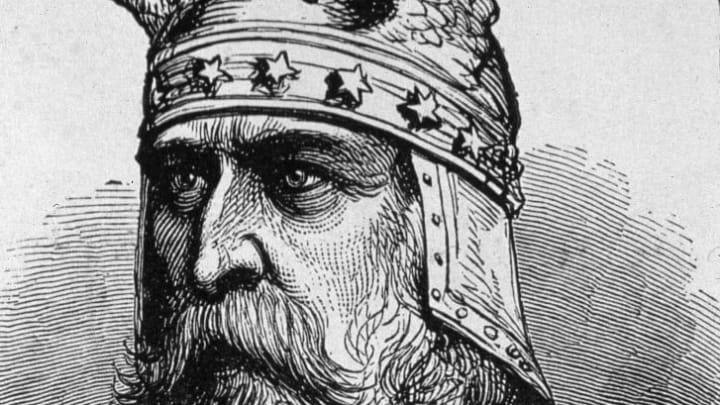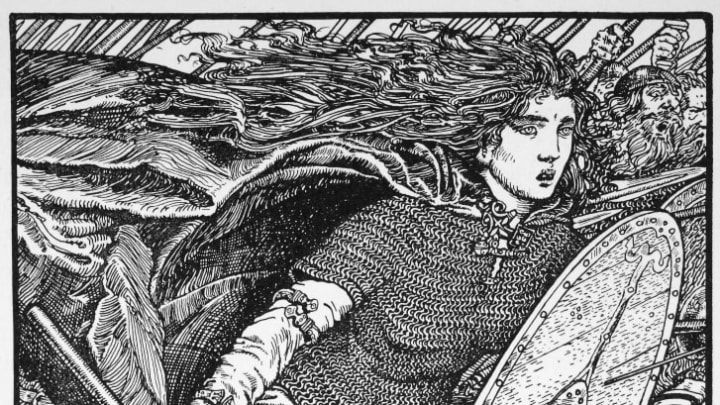Vikings are the focus of countless movies, TV shows, video games, sports teams, and comic books today—but that doesn’t mean we always get them right. From the myths surrounding their horned helmets to their not-so-fiery burial customs, here are some common misconceptions about Vikings, adapted from an episode of Misconceptions on YouTube.
1. Misconception: Vikings Wore Horned Helmets.
In 1876, German theatergoers were abuzz about a hot new ticket in town. Titled Der Ring des Nibelungen, or The Ring of the Nibelung, Richard Wagner’s musical drama played out over an astounding 15 hours and portrayed Norse and German legends all vying for a magical ring that could grant them untold power. To make his characters look especially formidable, costume designer Carl Emil Doepler made sure they were wearing horned helmets.
Though the image of Vikings plundering and pillaging while wearing horned helmets has permeated popular fiction ever since, the historical record doesn’t quite line up with it. Viking helmets were typically made of iron or leather, and it’s possible some Vikings went without one altogether, since helmets were an expensive item at the time. In fact, archaeologists have uncovered only one authentic Viking helmet, and it was made of iron and sans horns, which some historians and battle experts believe would have had absolutely no combat benefit whatsoever.
So where did Doepler get the idea for horned helmets from? There were earlier illustrations of Vikings in helmets that were occasionally horned (but more often winged). There were also Norse and Germanic priests who wore horned helmets for ceremonial purposes. This was centuries before Vikings turned up, though. Some historians argue that there is some evidence of ritualistic horned helmets in the Viking Age, but if they existed, they would have been decorative horns that priests wore—not something intended for combat.
Composer Richard Wagner apparently wasn’t pleased with the wardrobe choices; he didn’t want his opera to be mired in cheap tropes or grandiose costumes. Wagner’s wife, Cosima, was also irritated, saying that Doepler’s wardrobe smacked of “provincial tastelessness.”
The look wound up taking hold when Der Ring des Nibelungen went on tour through Europe in the late 19th and early 20th centuries. Other artists were then inspired by the direction of the musical and began using horned Viking helmets in their own depictions, including in children’s books. Pretty soon, it was standard Viking dress code.
2. Misconception: All Vikings Had Scary Nicknames.

When tales of Viking action spread throughout Europe, they were sometimes accompanied by ferocious-sounding nicknames like Ásgeirr the Terror of the Norwegians and Hlif the Castrator of Horses. This may have been a handy way to refer to Vikings with reputations for being hardcore at a time when actual surnames were in short supply. If you wanted to separate yourself from others with the same name, you needed a nickname. But plenty of them also had less intimidating labels.
Take, for instance, Ǫlver the Friend of Children. Sweet, right? Actually, Ǫlver got his name because he refused to murder children. Then there was Hálfdan the Generous and the Stingy with Food, who was said to pay his men very generously, but apparently didn’t feed them, leading to this contradictory nickname. Ragnarr Hairy Breeches was said to have donned furry pants when he fought a dragon.
Other unfortunate-but-real Viking names include Ulf the Squint-Eyed, Eirik Ale-Lover, Eystein Foul-Fart, Skagi the Ruler of Shit, and Kolbeinn Butter Penis. While the historical record is vague on how these names came to be, the truth is never going to be as good as whatever it is you’re thinking right now.
3. Misconception: Vikings Had Viking Funerals.
When someone like Kolbeinn Butter Penis died, it would only be fitting that they were laid to rest with dignity. And if you know anything about Vikings from pop culture, you know that meant setting them on fire and pushing them out to sea.
But as cool as that visual may be, it’s not exactly accurate. Vikings had funerals similar to pretty much everyone else. When one of them died, they were often buried in the ground. Archaeologists in Norway uncovered one such burial site in 2019, where at least 20 burial mounds were discovered.
The lead archaeologist on the site, Raymond Sauvage of the Norwegian University of Science and Technology, told Atlas Obscura that:
“We have no evidence for waterborne Viking funeral pyres in Scandinavia. I honestly do not know where this conception derives from, and it should be regarded as a modern myth. Normal burial practice was that people were buried on land, in burial mounds.”
The flaming ship myth may have come from a combination of two real Viking death practices. Vikings did sometimes entomb their dead in their ships, although the vessels remained on land where they were buried. And they did sometimes have funeral pyres. At some point in the historical record, someone may have combined these two scenarios and imagined that Vikings set ships ablaze before sending them out to sea with their dead still on board.
4. Misconception: Vikings Were Experienced and Trained Combat Soldiers.

While it’s true Vikings were violent, they weren’t necessarily the most experienced or talented warriors of their day. In fact, they were mostly normal people who decided plundering would be a great side hustle in the gig economy of Europe.
Historians believe Vikings were made up mostly of farmers, fishermen, and even peasants, rather than burly Conan the Barbarian types. Considering that the coastal villages they attacked probably didn’t put up much resistance, one could be a Viking and not even have to fight all that much. This leads to another common misconception—that Vikings were always swinging swords around. Like helmets, swords were expensive. A day of fighting was more likely to include spears, axes, long knives, or a bow and arrow.
You can blame this fierce warrior rep on the one squad of Vikings that actually fit the bill. Known as berserkers, these particular Vikings worshipped Odin, the god of war and death, and took Odin’s interests to heart. Some berserkers were said to have fought so fiercely that it was as though they had entered a kind of trance. If they were waiting around too long for a fight to start, it was said they might start killing each other.
5. Misconception: Vikings Were Dirty, Smelly, and Gross.
Most depictions of Vikings would have you believe that they were constantly caked in mud, blood, and other miscellaneous funk. Don’t fall for it. Archaeologists have unearthed a significant amount of personal grooming products over the years that belonged to Vikings, including tweezers, combs, toothpicks, and ear cleaners.
Vikings were also known to have bathed at least once a week, which was a staggeringly hygienic schedule for 11th-century Europe. In fact, Vikings put so much attention on bathing that Saturday was devoted to it. They called it Laugardagur, or bathing day. They even had soap made from animal fat.
Hygiene was only one aspect of their routine. Vikings put time and effort into styling their hair and sometimes even dyed it using lye. Their beards were neatly trimmed, and they were also known to wear eyeliner. All of this preening was said to make Vikings a rather attractive prospect to women in villages they raided, as other men of the era were somewhat reluctant to bathe.
6. Misconception: There Were No Viking Women.

Considering the times, Vikings actually had a fairly progressive approach to gender roles. Women could own property, challenge any kind of marriage arrangement, and even request a divorce if things weren’t working out at home. To do so, at least as one story tells it, they’d have to ask witnesses to come over, stand near her bed, and watch as she declared a separation.
In addition to having a relatively high degree of independence, Viking women were also known to pick up a weapon and bash some heads on occasion. The historical record of a battle in 971 CE says that women had fought and died alongside the men. A woman who donned armor was known as a “shieldmaiden.” According to legend, over 300 shieldmaidens fought in the Battle of Brávellir in the 8th century and successfully kept their enemies at bay.
According to History, one of the most notable shieldmaidens was a warrior named Lathgertha who so impressed a famous Viking named Ragnar Lothbrok—he of the Hairy Breeches—that he became smitten and asked for her hand in marriage.








